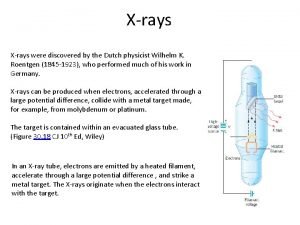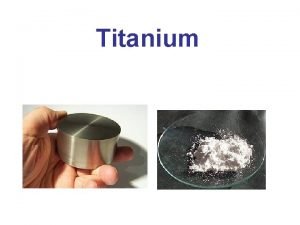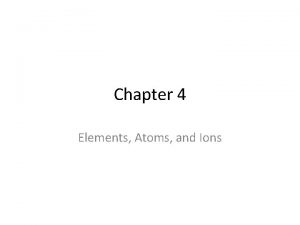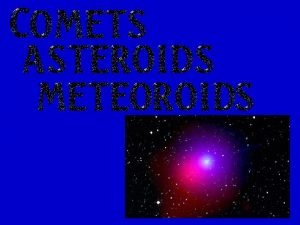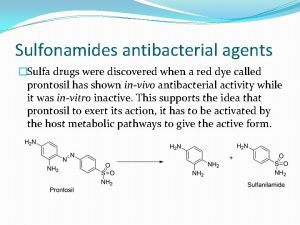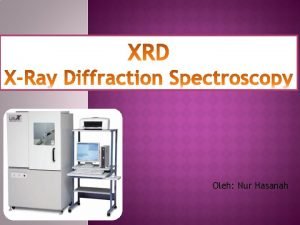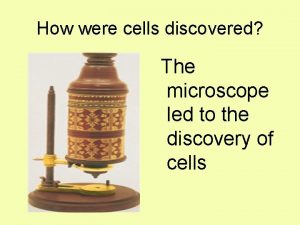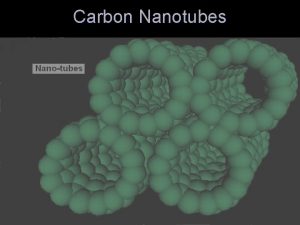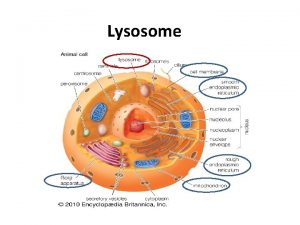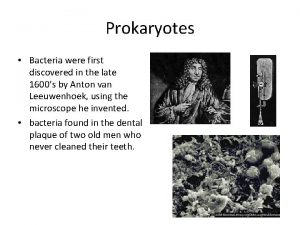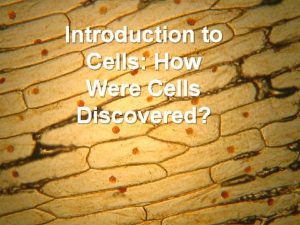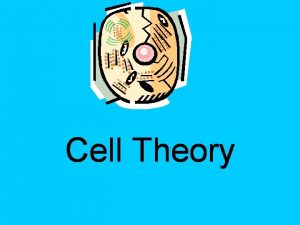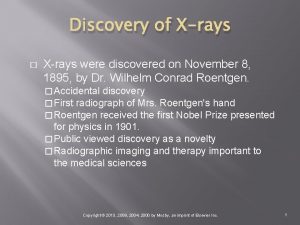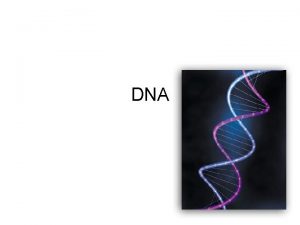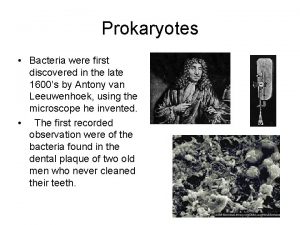CHAPTER 5 When the Elements Were Discovered 4





![Electron Configurations of Cations and Anions Of Representative Elements Na: [Ne]3 s 1 Na+ Electron Configurations of Cations and Anions Of Representative Elements Na: [Ne]3 s 1 Na+](https://slidetodoc.com/presentation_image_h2/b8d83364f1a8340074d535a78d53f886/image-6.jpg)









































- Slides: 47

CHAPTER 5

When the Elements Were Discovered

4 f 5 f d 10 d 5 d 1 ns 2 np 6 ns 2 np 5 ns 2 np 4 ns 2 np 3 ns 2 np 2 ns 2 np 1 ns 1 Ground State Electron Configurations of the Elements

The Modern Periodic Table Noble Gas Halogen Group Alkali Metal Alkali Earth Metal Period

Classification of the Elements
![Electron Configurations of Cations and Anions Of Representative Elements Na Ne3 s 1 Na Electron Configurations of Cations and Anions Of Representative Elements Na: [Ne]3 s 1 Na+](https://slidetodoc.com/presentation_image_h2/b8d83364f1a8340074d535a78d53f886/image-6.jpg)
Electron Configurations of Cations and Anions Of Representative Elements Na: [Ne]3 s 1 Na+ [Ne] Ca: [Ar]4 s 2 Ca 2+ [Ar] Al: [Ne]3 s 23 p 1 Al 3+ [Ne] H: 1 s 1 Atoms lose electrons so that cation has a noble-gas outer electron configuration. H- 1 s 2 or [He] Atoms gain electrons so - 1 s 22 p 6 or [Ne] 22 s 22 p 5 F: 1 s F that anion has a noblegas outer electron O: 1 s 22 p 4 O 2 - 1 s 22 p 6 or [Ne] configuration. N: 1 s 22 p 3 N 3 - 1 s 22 p 6 or [Ne]

-1 -2 -3 +3 +2 +1 Cations and Anions Of Representative Elements

Isoelectronic: have the same number of electrons, and hence the same ground-state electron configuration Na+: [Ne] Al 3+: [Ne] O 2 -: 1 s 22 p 6 or [Ne] F-: 1 s 22 p 6 or [Ne] N 3 -: 1 s 22 p 6 or [Ne] Na+, Al 3+, F-, O 2 -, and N 3 - are all isoelectronic with Ne What neutral atom is isoelectronic with H- ? H- : 1 s 2 same electron configuration as He

Electron Configurations of Cations of Transition Metals When a cation is formed from an atom of a transition metal, electrons are always removed first from the ns orbital and then from the (n – 1)d orbitals. Fe: [Ar]4 s 23 d 6 Fe 2+: [Ar]4 s 03 d 6 or [Ar]3 d 6 Fe 3+: [Ar]4 s 03 d 5 or [Ar]3 d 5 Mn: [Ar]4 s 23 d 5 Mn 2+: [Ar]4 s 03 d 5 or [Ar]3 d 5

Effective nuclear charge (Zeff) is the “positive charge” felt by an electron. Zeff = Z - s 0 < s < Z (s = shielding constant) Zeff Z – number of inner or core electrons Z Core Zeff Radius (pm) Na 11 10 1 186 Mg 12 10 2 160 Al 13 10 3 143 Si 14 10 4 132

Effective Nuclear Charge (Zeff) increasing Zeff

Atomic Radii covalent radius metallic radius


increasing atomic radius Decreasing atomic radius

Trends in Atomic Radii

Comparison of Atomic Radii with Ionic Radii

• Cation is always smaller than atom from which it is formed. • Anion is always larger than atom from which it is formed.

The Radii (in pm) of Ions of Familiar Elements



Ionization energy is the minimum energy (k. J/mol) required to remove an electron from a gaseous atom in its ground state. I 1 + X (g) X+(g) + e- I 1 first ionization energy I 2 + X+(g) X 2+(g) + e- I 2 second ionization energy I 3 + X 2+(g) X 3+(g) + e- I 3 third ionization energy I 1 < I 2 < I 3


Variation of the First Ionization Energy with Atomic Number Filled n=1 shell Filled n=2 shell Filled n=3 shell Filled n=4 shell Filled n=5 shell

General Trends in First Ionization Energies Increasing First Ionization Energy


Electron affinity is the negative of the energy change that occurs when an electron is accepted by an atom in the gaseous state to form an anion. X (g) + e- X-(g) F (g) + e- X-(g) DH = -328 k. J/mol EA = +328 k. J/mol O (g) + e- O-(g) DH = -141 k. J/mol EA = +141 k. J/mol


Variation of Electron Affinity With Atomic Number (H – Ba)

General Trends in Electron Affinity Electron affinity decrease Electron affinity increase

Electronegatively The ability of an atom to attract electrons (or electron density) towards itself in a covalent bond. electronegativity decrease electronegativity increase

Group 1 A Elements (ns 1, n 2) M M+1 + 1 e- 2 M(s) + 2 H 2 O(l) Increasing reactivity 4 M(s) + O 2(g) 2 MOH(aq) + H 2(g) 2 M 2 O(s)

Group 1 A Elements (ns 1, n 2)

Group 2 A Elements (ns 2, n 2) M M+2 + 2 e- Be(s) + 2 H 2 O(l) Mg(s) + 2 H 2 O(g) Increasing reactivity M(s) + 2 H 2 O(l) No Reaction Mg(OH)2(aq) + H 2(g) M = Ca, Sr, or Ba

Group 2 A Elements (ns 2, n 2)

Group 3 A Elements (ns 2 np 1, n 2) 4 Al(s) + 3 O 2(g) 2 Al(s) + 6 H+(aq) 2 Al 2 O 3(s) 2 Al 3+(aq) + 3 H 2(g)

Group 3 A Elements (ns 2 np 1, n 2)

Group 4 A Elements (ns 2 np 2, n 2) Sn(s) + 2 H+(aq) Sn 2+(aq) + H 2 (g) Pb(s) + 2 H+(aq) Pb 2+(aq) + H 2 (g)

Group 4 A Elements (ns 2 np 2, n 2)

Group 5 A Elements (ns 2 np 3, n 2) N 2 O 5(s) + H 2 O(l) P 4 O 10(s) + 6 H 2 O(l) 2 HNO 3(aq) 4 H 3 PO 4(aq)

Group 5 A Elements (ns 2 np 3, n 2)

Group 6 A Elements (ns 2 np 4, n 2) SO 3(g) + H 2 O(l) H 2 SO 4(aq)

Group 6 A Elements (ns 2 np 4, n 2)

Group 7 A Elements (ns 2 np 5, n 2) X 2(g) + H 2(g) X -1 2 HX(g) Increasing reactivity X + 1 e-

Group 7 A Elements (ns 2 np 5, n 2)

Group 8 A Elements (ns 2 np 6, n 2) Completely filled ns and np subshells. Highest ionization energy of all elements. No tendency to accept extra electrons.

Compounds of the Noble Gases A number of xenon compounds Xe. F 4, Xe. O 3, Xe. O 4, Xe. OF 4 exist. A few krypton compounds (Kr. F 2, for example) have been prepared.

Comparison of Group 1 A and 1 B The metals in these two groups have similar outer electron configurations, with one electron in the outermost s orbital. Chemical properties are quite different due to difference in the ionization energy. Lower I 1, more reactive
 When were carrots discovered
When were carrots discovered How were xrays discovered
How were xrays discovered Was/were going to
Was/were going to Hát kết hợp bộ gõ cơ thể
Hát kết hợp bộ gõ cơ thể Frameset trong html5
Frameset trong html5 Bổ thể
Bổ thể Tỉ lệ cơ thể trẻ em
Tỉ lệ cơ thể trẻ em Chó sói
Chó sói Glasgow thang điểm
Glasgow thang điểm Chúa yêu trần thế
Chúa yêu trần thế Môn thể thao bắt đầu bằng từ chạy
Môn thể thao bắt đầu bằng từ chạy Thế nào là hệ số cao nhất
Thế nào là hệ số cao nhất Các châu lục và đại dương trên thế giới
Các châu lục và đại dương trên thế giới Công thức tính độ biến thiên đông lượng
Công thức tính độ biến thiên đông lượng Trời xanh đây là của chúng ta thể thơ
Trời xanh đây là của chúng ta thể thơ Mật thư tọa độ 5x5
Mật thư tọa độ 5x5 101012 bằng
101012 bằng độ dài liên kết
độ dài liên kết Các châu lục và đại dương trên thế giới
Các châu lục và đại dương trên thế giới Thơ thất ngôn tứ tuyệt đường luật
Thơ thất ngôn tứ tuyệt đường luật Quá trình desamine hóa có thể tạo ra
Quá trình desamine hóa có thể tạo ra Một số thể thơ truyền thống
Một số thể thơ truyền thống Cái miệng xinh xinh thế chỉ nói điều hay thôi
Cái miệng xinh xinh thế chỉ nói điều hay thôi Vẽ hình chiếu vuông góc của vật thể sau
Vẽ hình chiếu vuông góc của vật thể sau Nguyên nhân của sự mỏi cơ sinh 8
Nguyên nhân của sự mỏi cơ sinh 8 đặc điểm cơ thể của người tối cổ
đặc điểm cơ thể của người tối cổ Thế nào là giọng cùng tên?
Thế nào là giọng cùng tên? Vẽ hình chiếu đứng bằng cạnh của vật thể
Vẽ hình chiếu đứng bằng cạnh của vật thể Tia chieu sa te
Tia chieu sa te Thẻ vin
Thẻ vin đại từ thay thế
đại từ thay thế điện thế nghỉ
điện thế nghỉ Tư thế ngồi viết
Tư thế ngồi viết Diễn thế sinh thái là
Diễn thế sinh thái là Các loại đột biến cấu trúc nhiễm sắc thể
Các loại đột biến cấu trúc nhiễm sắc thể Các số nguyên tố
Các số nguyên tố Tư thế ngồi viết
Tư thế ngồi viết Lời thề hippocrates
Lời thề hippocrates Thiếu nhi thế giới liên hoan
Thiếu nhi thế giới liên hoan ưu thế lai là gì
ưu thế lai là gì Hổ sinh sản vào mùa nào
Hổ sinh sản vào mùa nào Sự nuôi và dạy con của hươu
Sự nuôi và dạy con của hươu Hệ hô hấp
Hệ hô hấp Từ ngữ thể hiện lòng nhân hậu
Từ ngữ thể hiện lòng nhân hậu Thế nào là mạng điện lắp đặt kiểu nổi
Thế nào là mạng điện lắp đặt kiểu nổi Scientists recently discovered that rocks collected
Scientists recently discovered that rocks collected Titanium group elements
Titanium group elements Research strategies
Research strategies

